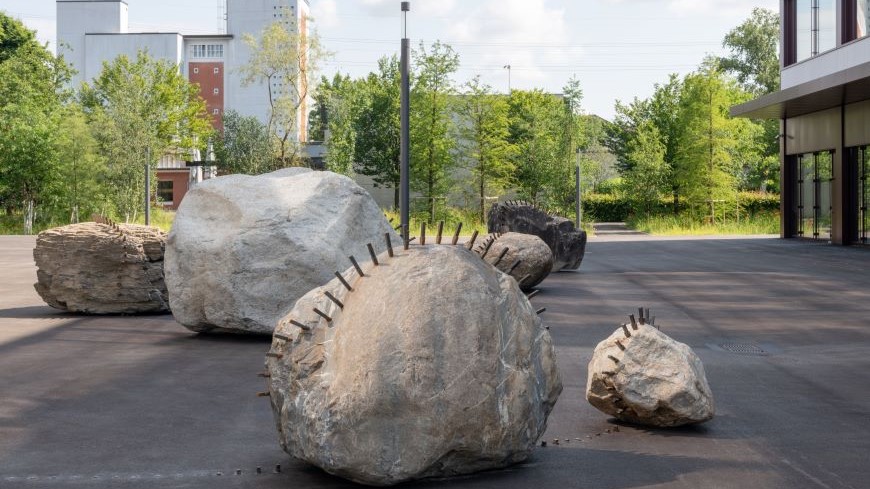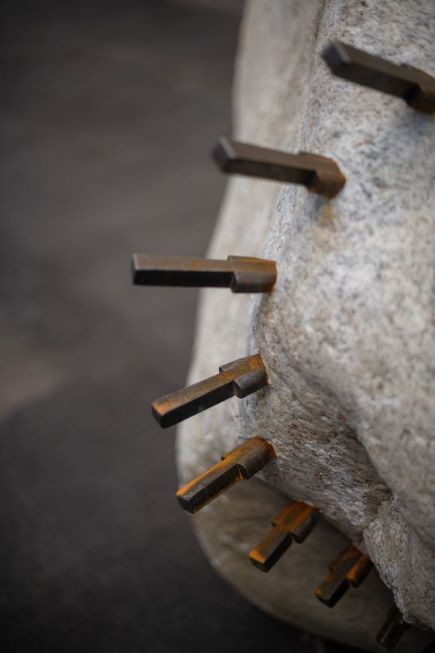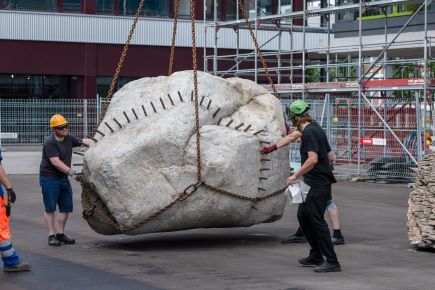Artwork on campus: Not to Get Lost
Boulders for the research campus
On the Empa and Eawag campus in Dübendorf, artist Julian Charrière has created an installation with boulders of different origins, sizes and compositions. The stones are connected by metallic stone wedges that run through the asphalt and stretch across the boulders – symbolizing the long path from research to application.

There is something mystical about boulders. Their presence alone is fascinating, when they lie alone or in groups in the middle of a landscape. This is why such sites have often been regarded as cult places or are popular excursion destinations. Now the work of the internationally renowned artist Julian Charrière on the new Empa and Eawag campus invites visitors to explore such boulders, which have traveled a long way due to the advancing glacial ice. With Not to Get Lost, Charrière has created a monumental installation composed of eight boulders for the square between NEST and the new Empa laboratory building.
Resourceful foundlings

The massive installation is connected by a series of metal wedges that form a line running across the stones. According to the artist, this geological linking of dots refers both to the history of stonemasonry and quarrying and to the myth and scientific mystery that once surrounded these migrating minerals. What was once perceived as a mysterious religious movement later gave way to glaciological, geological and mineralogical research findings. “The connected boulders in the installation thus function as an interface between nature, culture and technology. Whether it is art that sketches visions or science that maps reality: Both begin with the drawing of a line,” says Charrière. Likewise, scientific projects do not always develop in a linear fashion, but often have to follow winding paths with obstacles – like the metal wedges of Not to Get Lost.
“With this work, Empa and Eawag want to send a tongue-in-cheek impulse to their researchers – to take the path of science, which can sometimes lead over “rocky terrain”, with a little lightness and embrace the playful flow of this installation,” explains curator Friederike Schmid, who accompanied the process. “Moreover, stonemasonry is one of the primal crafts – opening something up, as you can with these wedges, serves research and the idea of gaining knowledge from within.” The fact that Charrière's installation offers these and other interpretations is a strength of his work. Public works in particular must pick people up on different levels and always offer space for further discoveries and deciphering.
Place with character

The Not to Get Lost installation won an invitation-only competition against five submitted projects. According to Kevin Olas, Head of Real Estate at Empa, the jury unanimously chose the project by Julian Charrière because it creates a dramaturgy and connects the campus by depicting the long path from research to application. It occupies the space between the existing and new buildings with a monumental installation. “The artwork gives the square character. It creates strong contrasts between the buildings, which are very technical in contrast to the brute boulders – and thus creates a tension that inspires visitors and employees to make a wide variety of associations.” Friederike Schmid adds: “At first glance, it looks like the garden of a giant, playfully designed as an archaic antithesis to urban architecture.”
From a logistical point of view, the art project proved to be quite challenging, as the eight boulders came from all over Switzerland – one even from the excavation of the new campus buildings. The lightest stone weighs one ton, the heaviest 20 tons. These had to be scattered from St. Gallen, Bern and Uri to Ticino and transported to a stonemason's workshop, where they were first scanned and then prepared by machine to set the stone wedges. The boulders were recently placed precisely on site in Dübendorf using a crane under the coordination of the artist. Now they are waiting to be explored.
Artist Julian Charrière
Julian Charrière was born in 1987 in Morges, canton of Vaud, and lives in Berlin. He studied art at the École cantonale d'art du Valais before moving to Germany to complete his degree with the internationally renowned artist Olafur Eliasson at the Universität der Künste Berlin. Charrière deals intensively with scientific themes on an ecological, universal and anthropological level. He combines environmental science and cultural history and his projects often result from field research in remote places such as volcanoes, ice fields or radioactively contaminated test sites. With his work Not to Get Lost in Dübendorf, Empa can build on significant works of art such as those installed in St. Gallen by Roman Signer and Jürg Altherr.
Kevin Olas
Head of Real Estate Services
Empa, Real Estate Services
Phone +41 58 765 41 64
Friederike Schmid
Communication by Art GmbH
Phone +41 79 501 16 31
-
Share







